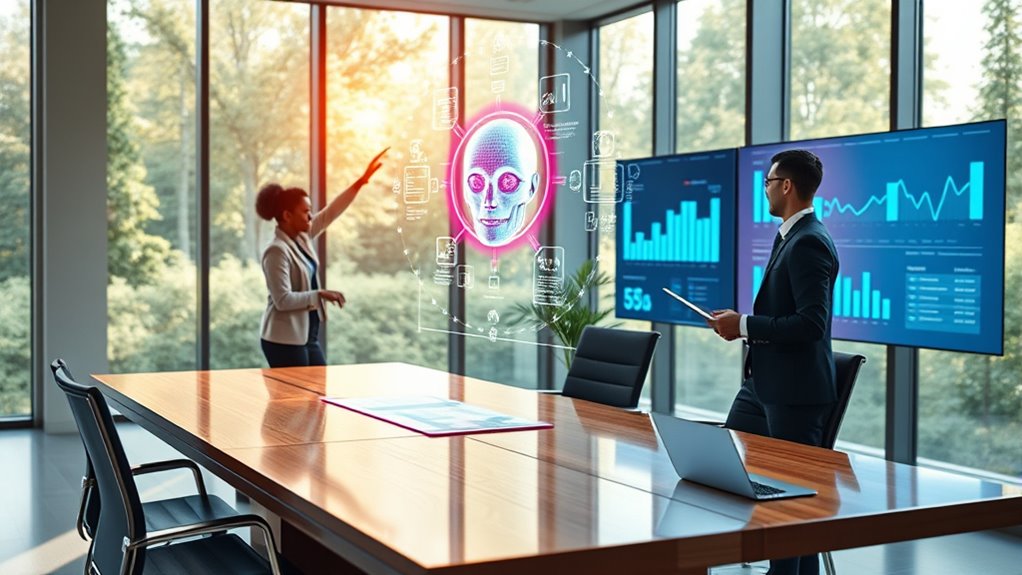AI, especially large language models, is transforming your daily work by automating routine tasks like emails, scheduling, and data management. It boosts your productivity by providing smarter insights, faster content creation, and personalized workflows. Different roles benefit uniquely—from faster content for creatives to better decision support for managers. Staying updated through effective training helps you leverage AI’s full potential. If you keep exploring, you’ll discover how these changes impact your work environment even more.
Key Takeaways
- Large Language Models (LLMs) automate routine tasks like drafting emails, reports, and data analysis, increasing office efficiency.
- LLMs support personalized workflows, helping employees quickly generate ideas and improve decision-making processes.
- They enhance collaboration by providing real-time language translation, summarization, and contextual insights.
- LLMs enable smarter knowledge management through quick information retrieval and content organization.
- Ongoing training on LLMs fosters responsible use, ensuring ethical, transparent, and privacy-conscious AI integration in daily work.
The Growing Adoption of AI in Professional Settings

The adoption of AI in professional settings is accelerating rapidly, transforming how businesses operate and compete. In 2024, 78% of organizations use AI, up from 55% the previous year, showing quick growth. Between 2015 and 2019, the number of companies adopting AI services surged by 270%. Nearly half of businesses have active plans to implement AI soon, highlighting widespread engagement. About one-third of organizations already use AI, and 42% are considering it in the near future. Globally, AI adoption is expected to grow at a compound annual rate of 35.9% from 2025 to 2030. This trend is driven by technological advances, economic benefits, and the need to stay competitive in an increasingly digital marketplace. Additionally, the growth of AI technology is making it more accessible and effective for a wide range of professional applications. As the technology develops, integrating AI-powered tools into daily workflows is becoming more seamless and efficient. The increasing integration of automation and AI-driven solutions is also helping organizations address complex data privacy challenges more effectively. Moreover, the rapid evolution of machine learning models is enabling more sophisticated decision-making processes across industries. Developing a strong cultural intelligence within teams can further enhance the successful integration of AI solutions by ensuring cross-cultural understanding and collaboration.
How AI Enhances Productivity Across Tasks

AI streamlines routine tasks, freeing you to focus on more strategic work and boosting your overall productivity. It also enhances creative output by offering tools for idea generation and content creation. By automating repetitive work and supporting innovation, AI helps you work smarter and faster. AI’s ability to automate cognitive functions surpasses traditional automation, enabling more efficient workflows and decision-making. Additionally, its capacity to adapt to various office tasks allows for a more flexible and responsive work environment. Incorporating AI-driven solutions can also improve overall employee satisfaction by reducing mundane workload. Furthermore, integrating AI with Kia Tuning technologies exemplifies how automation can optimize complex systems for better performance and efficiency. Leveraging automation in the workplace further enhances operational effectiveness and fosters innovation. As organizations adopt these AI tools, they can also benefit from personalized workflows, which tailor processes to individual or team needs, increasing overall efficiency.
Streamlining Routine Tasks
By automating repetitive tasks such as data entry, scheduling, and document processing, AI considerably boosts your productivity. It frees up your time, allowing you to focus on higher-value work. Generative AI users report saving around 5.4% of their work hours, translating to more efficiency. AI handles routine tasks quickly and accurately, reducing errors and workload. It also helps optimize workflows by identifying inefficiencies and suggesting improvements, making your processes smoother. Business leaders observe significant productivity gains, with 72% citing notable benefits from extensive AI use. This automation streamlines daily operations, minimizes manual effort, and accelerates task completion, enabling you to allocate your energy to strategic activities and decision-making. Additionally, workflow optimization can further enhance overall efficiency by systematically refining processes and eliminating redundancies. Moreover, the integration of automation with AI-driven analytics provides deeper insights into operational performance, fostering smarter decisions. As the availability of local legal resources increases, organizations can better tailor their AI implementations to regional needs, further boosting efficiency. Additionally, advancements in personal development tools powered by AI are helping individuals improve well-being and self-awareness in the workplace. AI adoption rate in workplaces continues to grow, further enhancing its role in transforming daily work. Additionally, as emotional support becomes crucial, AI tools are being developed to help manage workplace stress and promote well-being, contributing to a healthier work environment. AI’s role in routine task management transforms how you work, making your day more efficient.
Boosting Creative Output
Building on how automation streamlines routine tasks, leveraging AI to boost creative output can substantially elevate your overall productivity. AI tools help you generate ideas faster, freeing you from repetitive work and allowing more focus on innovation. With 75% of workers using AI at work, you’re likely to experience significant benefits. AI-driven content creation and data analysis inspire fresh perspectives and new approaches. Imagine:
- Opening innovative ideas quickly, sparking excitement and motivation.
- Saving hours weekly, giving you more time for creative exploration.
- Collaborating seamlessly with AI to refine your projects, boosting confidence and satisfaction.
Variations in AI Benefits by Occupation

Different occupations experience distinct benefits from AI adoption, depending on their specific tasks and workflows. For creative roles, AI speeds up content creation, offers suggestions, and automates routine tasks, freeing you to focus on high-value work. In administrative roles, AI automates data entry, manages schedules, and provides decision support, improving efficiency and work-life balance. Professional service providers benefit from personalized learning tools, real-time feedback, and data-driven insights that enhance decision-making and client interactions. Technical roles see the emergence of new job categories like AI specialists, while existing roles leverage AI for automation and innovation. Overall, AI adapts to your occupation’s needs, amplifying strengths and addressing challenges, but the degree of benefit varies based on your specific tasks and how effectively you integrate AI tools into your daily routines. AI’s transformative impact is increasingly shaping how work gets done across various sectors, highlighting the importance of adapting skills to stay competitive. Additionally, understanding grocery store hours can help workers better plan their shopping or shifts, demonstrating how knowledge of operational timings influences daily routines and productivity. Furthermore, integrating industry-specific tools such as AP Tuning for automotive diagnostics can further optimize workflows and improve outcomes. Recognizing the potential for industry-specific applications allows professionals to tailor AI tools to their unique needs, maximizing efficiency and effectiveness. Moreover, leveraging predictive modeling can assist in forecasting future demands and optimizing resource allocation within different occupational contexts. Considering the role of meditation and related practices can also support mental clarity and resilience in high-stress environments, contributing to overall productivity and well-being.
The Role of Training in Maximizing AI Gains

To get the most out of AI, you need effective skill development that aligns with new tools and workflows. Ongoing user education keeps staff updated on best practices and helps them adapt quickly. By investing in continuous training, you guarantee your team maximizes AI’s potential and stays ahead. Incorporating automated testing tools into training programs can further streamline workflows and improve software quality. Understanding how auditory processing influences perceptions can also enhance team dynamics and interpersonal communication in the workplace. Additionally, understanding support hours for various entertainment venues can aid in planning team outings and morale-building activities.
Effective Skill Development
Effective skill development is essential for maximizing AI gains in the workplace, as training directly influences how well you can adopt and leverage new technologies. When you invest in targeted training, you bridge the skills gap and boost your confidence in using AI tools. Companies that prioritize strategic training often see higher employee engagement and better AI utilization. For example, understanding the hourly store hours of beauty retailers can help employees better serve customers and manage inventory efficiently. Additionally, incorporating natural materials and textures into training scenarios can enhance learning engagement and retention. Emphasizing the importance of educational and skill-building toys can foster foundational skills that support AI integration in early learning environments. Consider these impactful approaches: 1. Combine technical and soft skills to use AI effectively across tasks. 2. Use blended learning methods** like online courses, workshops, and mentorships for better retention. 3. Incorporate real-world scenarios** in training to build confidence and reduce errors.
Ongoing User Education
How can ongoing training unlock the full potential of AI in your workplace? Continuous education helps you stay ahead as AI tools evolve. With over 70% of employees believing generative AI enhances learning and creativity, ongoing training guarantees you leverage these benefits fully. Since nearly all jobs now require digital skills, regular updates keep your team competitive. AI-powered assistants, chatbots, and data analytics make training more personalized and engaging, boosting performance and retention. Despite high interest, only a third of companies have clear AI skill policies, highlighting the need for ongoing education. Embracing continuous learning helps you adapt to an evolving business environment, improve productivity, and gain a competitive edge. Investing in ongoing AI training is essential for maximizing its value in your daily work.
AI’s Influence on Job Roles and Market Dynamics

AI is transforming job roles and market dynamics by automating routine tasks and creating new opportunities that demand advanced skills. You’ll see jobs displaced—especially entry-level roles—while new positions requiring critical thinking, creativity, and technical expertise emerge. This shift can be both promising and challenging.
AI is reshaping jobs by automating routine tasks and creating new, skill-intensive opportunities.
Consider these impacts:
- Job creation outweighs displacement—but the race to adapt can feel overwhelming.
- Entry-level opportunities shrink, making it harder for new workers to break in and lowering salaries.
- Competition intensifies, pushing companies to adopt AI faster to stay ahead.
You might face uncertainty, but developing AI-related skills can position you at the forefront of this evolving market, turning challenges into opportunities for growth.
Specific Sectors Benefiting From AI Integration

Several key sectors are experiencing significant benefits from integrating AI technology, leading to improved efficiency, accuracy, and innovation. Healthcare uses AI for personalized treatments, diagnostics, and predictive analytics to advance medical research. AI-powered wearables and imaging tools help with preventive care and precise diagnoses. In finance, AI enhances fraud detection, optimizes investment strategies, and streamlines risk management. Customer service improves through AI chatbots, while compliance monitoring guarantees regulatory adherence. Manufacturing benefits from AI-driven quality control, predictive maintenance, and supply chain optimization, reducing waste and downtime. Education leverages AI for personalized learning, predictive analytics on student progress, and administrative automation. Logistics and transportation utilize AI for route optimization, real-time tracking, and predictive maintenance, making supply chains more responsive and efficient.
Challenges in Implementing AI Solutions

Implementing AI solutions in the workplace often presents a complex set of challenges that organizations must navigate carefully. You may worry about job displacement, as 14% of workers have faced layoffs due to automation. Cybersecurity risks are a major concern, with 51% of employees citing them as a top issue. Additionally, AI can produce biased or inaccurate results if trained on flawed data, leading to unfair outcomes. You also face the hurdle of regulatory compliance, affecting 28% of organizations, and the need for workforce adaptation, requiring swift skill updates.
1. The fear of job loss can create resistance.
2. Security breaches threaten company trust.
3. Biases compromise AI fairness and transparency.
Future Trends and Advancements in Office AI

Advancements in office AI are making tools more compact, efficient, and accessible, enabling smoother integration into daily workflows. Smaller models like TinyLlama and Mixtral cut costs while maintaining quality, making AI more deployable across mobile apps, startups, and education. Sparse expert models activate only relevant network parts, boosting speed and energy efficiency. Ongoing research balances model size with performance, optimizing resource use. Real-time data integration allows AI to access live internet information, supporting accurate fact-checking and up-to-date insights. Future tools will automatically include references, increasing transparency. Additionally, self-improving models generate synthetic training data, reducing costs and customizing AI for niche domains. These trends drive smarter, faster, and more adaptable office AI solutions, transforming how you work daily.
Building a Responsible Framework for AI Use

As office AI tools become more powerful and integrated into daily workflows, establishing a responsible framework for their use is essential to guarantee ethical and trustworthy deployment. You need to embrace ethical AI principles like fairness, privacy, and transparency, ensuring these guide every decision. Clearly defining roles and responsibilities keeps accountability front and center. Continuous learning and regular training help foster an ethical AI culture in your organization. Human-AI collaboration enhances oversight, making systems more reliable. Finally, implementing governance frameworks and adhering to regulations ensures compliance and performance.
- Feel confident knowing your AI systems are fair, transparent, and accountable.
- Trust that ongoing learning keeps your organization ethically aligned.
- Rest assured your AI use promotes inclusivity and safeguards privacy.
Frequently Asked Questions
How Secure Is Data When Using AI Tools in the Office?
You might wonder how secure your data is when using AI tools in the office. While these tools boost productivity, they also introduce risks like data breaches, leaks, and cyberattacks. Security controls often lag behind AI adoption, making vulnerabilities worse. To protect your data, guarantee your organization invests in specialized AI security measures, enforces strict compliance, and maintains transparency about data handling practices. Staying informed and cautious is essential for safeguarding sensitive information.
Can AI Replace Human Decision-Making Entirely?
The idea of AI replacing human decision-making entirely is like expecting a robot to feel human emotions—impossible and overly optimistic. While AI can handle routine tasks and provide data insights, it struggles with complex, nuanced decisions requiring empathy, ethics, and deep understanding. You’ll find AI best when it complements your judgment, not replaces it, ensuring human oversight remains essential in critical decision-making processes.
What Are the Costs Associated With Implementing AI in Workplaces?
You should know that implementing AI in workplaces involves significant costs. Development expenses can range from $5,000 for basic models to over $500,000 for advanced ones. You’ll need to budget for hardware, infrastructure, and ongoing operational costs like maintenance and retraining, which can reach hundreds of thousands annually. Additionally, customizing AI and ensuring regulatory compliance add to the overall expenses, making strategic planning essential to maximize ROI.
How Do Privacy Concerns Impact AI Adoption?
Privacy concerns can feel like a wall of fog, making you hesitant to fully embrace AI. You worry about data leaks, unauthorized use, and compliance issues, which can slow down AI adoption. These fears lead you to question whether the benefits outweigh the risks, especially when trust in organizations is low. To move forward, clear policies and transparency are vital in easing these worries and enabling AI’s potential safely.
What Skills Will Be Most Valuable in Ai-Driven Workplaces?
In an AI-driven workplace, you’ll find that data literacy, critical thinking, collaboration, and ethical awareness become vital skills. You need to analyze and interpret AI outputs, make data-informed decisions, and visualize insights effectively. Critical thinking helps you identify problems and develop solutions, while teamwork ensures smooth AI integration. Ethical understanding ensures responsible use, and staying updated with regulations keeps you compliant. Together, these skills help you thrive in an AI-powered environment.
Conclusion
Just as Icarus learned the dangers of soaring too close to the sun, embracing AI in the office requires balance. You’re now empowered to harness its benefits while steering through challenges responsibly. By staying adaptable and committed to ethical use, you’ll shape a future where AI enhances your work without risking unintended consequences. Remember, it’s not just about flying high, but flying wisely—guiding your career with foresight and integrity.









